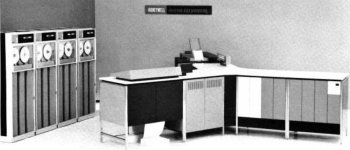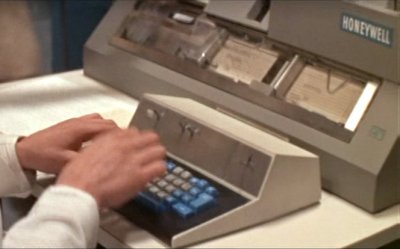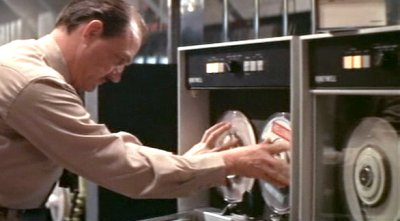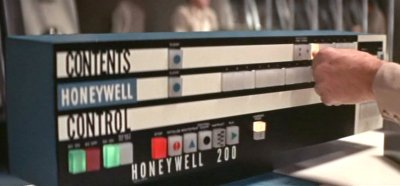

Honeywell H200 in Billion Dollar Brain (1967)
The Honeywell stands in as the titular billion dollar brain.


The computer directs all the activities of the FFF.


The billion dollar brain displays capabilities that were simply not possible in the late 1960s.


The images in the film are the best photographic record I can find of this machine.




Andrew L. Ayers
"The billion dollar brain displays capabilities that were simply not possible in the late 1960s." Hmm - I have never seen the movie, but I am curious as to what these "capabilities" were...?
2009-10-01 07:18
Bill Laing
"If my memory is correct, the actor actually pressed the correct buttons on the control panel to boot the card deck in. The picture here shows him entering 40 octal, then he pressed the bootstrap button." Your memory is better than mine then. I spent several years testing and repairing this range of computers circa 1970 at Honeywell's Newhouse plant in Scotland and you make just have pushed my recall button.
2017-07-26 13:02
Bill Laing
"If my memory is correct, the actor actually pressed the correct buttons on the control panel to boot the card deck in. The picture here shows him entering 40 octal, then he pressed the bootstrap button." Your memory is better than mine then. I spent several years testing and repairing this range of computers circa 1970 at Honeywell's Newhouse plant in Scotland and you make just have pushed my recall button.
2010-07-13 12:25
Peter
If my memory is correct, the actor actually pressed the correct buttons on the control panel to boot the card deck in. The picture here shows him entering 40 octal, then he pressed the bootstrap button.
2010-06-08 08:38
Peter Grange
If I recall correctly from seeing the film many years ago, the actor actually presses the correct buttons on the operator panel to bootload the card deck.
2017-07-26 13:02
Alan Jardine
Wasn't 41 the octal code for the card reader, 40 being for the tape system (which the guy is clearly setting up)? Also, the card punch / verifier is actually an IBM machine (model 026)? Further, the second row of buttons on the H200 control panel actually said "ADDRESS", not "HONEYWELL". Alan (at Honeywell Newhouse from 1965 - 1974).
2017-07-26 13:07
Alan Jardine
Wasn't 41 the octal code for the card reader, 40 being for the tape system (which the guy is clearly setting up)? Also, the card punch / verifier is actually an IBM machine (model 026)? Further, the second row of buttons on the H200 control panel actually said "ADDRESS", not "HONEYWELL". Alan (at Honeywell Newhouse from 1965 - 1974).
2017-07-26 13:07
Rob S
I am currently working on building a working replica of the Honeywell 200 and this film is a valuable source of colour images of one. I think I actually saw the film when it was released, at which time I was working as a Honeywell 200 programmer. Karl Malden actually entered octal 41, the standard channel number for the card reader, not 40 before he bootstrapped the machine. He clearly had to learn exactly which buttons to press as the machine wasn't capable of acting itself. I've no idea why he pressed the Enter button last though because that wouldn't have done anything. I don't think the machine was meant to be the titular brain as suggested as the Honeywell 200 was designed to be used as a front end device to a much more powerful computer in reality and that is how I see it being used in the film. I think the brain itself remained unidentified. Honeywell themselves had more powerful computers than the 200 at that time but the 200 was definitely photogenic and that's why it featured so prominently.
2013-02-15 19:02
Harry Stuart
Alan Jardine - you were right. 41 was the code for the card reader and I believe the address should have been 1680 - or close. You needed both to read cards from the card reader. I worked this machine 1965-67 in Melbourne, Australia and then 1967-70 at Honeywell in Toronto, Canada. Programmed in Easycoder (Honeywell assembly language) and later in Cobol.
2020-01-12 11:45
Raymond Hong
That first picture below is an IBM 029 keypunch machine. The film makers stuck a HONEYWELL label on top of the underlying IBM name.
2019-06-26 16:18
Tom Lake
In the first photo, that's an IBM 029 keypunch machine. I went through college typing on one of those. Honeywell may have sold it under their own label, though.
2021-04-19 06:41
Adam Sampson
From the Tech Ops site (http://tech-ops.co.uk/next/now-thats-a-good-spot/), for ex-BBC technical staff: "an episode of “Dr. Who” utilised banks of computers, the ones with spools of tape, hired in. These came from “The Billion Dollar Brain” starring Michael Caine. However, “Dr. Who” was transmitted well before the film came out." I'm not sure which episode this is referring to...
2021-04-26 22:14
Rich M.
As a retired Field Engineer for Honeywell, I can't tell you how many of those control panels I stood in front of. After powering up the memory was not initialized to a known state so the operator had to 'clear memory' by 'punching in' a few hardware commands using the buttons on the control panel. This set the parity properly in all memory locations. After that, one could "boot in" a program from the card reader (14) or tape drive. The system did not support booting from disk. Fun thing to do, was to boot the card punch or the printer which were output devices.
2023-02-18 15:42
Adam Sampson
Tech Ops mystery above solved: it was Out of the Unknown ("The Counterfeit Man"), not Doctor Who. Going by the stills on IMDB, Billion Dollar Brain also features a LEO II tape drive.
2023-12-20 20:08